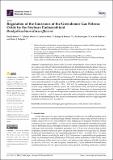Por favor, use este identificador para citar o enlazar a este item:
http://hdl.handle.net/10261/276466COMPARTIR / EXPORTAR:
 SHARE SHARE
 CORE
BASE CORE
BASE
|
|
| Visualizar otros formatos: MARC | Dublin Core | RDF | ORE | MODS | METS | DIDL | DATACITE | |

| Título: | Regulation of the emissions of the greenhouse gas nitrous oxide by the soybean endosymbiont Bradyrhizobium diazoefficiens |
Autor: | Bueno Romero, Emilio CSIC; Mania, D.; Mesa, Socorro CSIC ORCID; Bedmar, Eulogio J. CSIC ORCID; Frostegård, Åsa; Bakken, Lars Reier; Delgado Igeño, María Jesús CSIC ORCID | Palabras clave: | Dinitrogen Nitric oxide Nitrous oxide reductase Denitrification Gene expression |
Fecha de publicación: | 2022 | Editor: | Multidisciplinary Digital Publishing Institute | Citación: | International Journal of Molecular Sciences 23(3):1486 (2022) | Resumen: | The greenhouse gas nitrous oxide (N2O) has strong potential to drive climate change. Soils are a major source of N2O, with microbial nitrification and denitrification being the primary processes involved in such emissions. The soybean endosymbiont Bradyrhizobium diazoefficiens is a model microorganism to study denitrification, a process that depends on a set of reductases, encoded by the napEDABC, nirK, norCBQD, and nosRZDYFLX genes, which sequentially reduce nitrate (NO3) to nitrite (NO2), nitric oxide (NO), N2O, and dinitrogen (N2). In this bacterium, the regulatory network and environmental cues governing the expression of denitrification genes rely on the FixK2 and NnrR transcriptional regulators. To understand the role of FixK2 and NnrR proteins in N2O turnover, we monitored real-time kinetics of NO3, NO2, NO, N2O, N2, and oxygen (O2) in a fixK2 and nnrR mutant using a robotized incubation system. We confirmed that FixK2 and NnrR are regulatory determinants essential for NO3 respiration and N2O reduction. Furthermore, we demonstrated that N2O reduction by B. diazoefficiens is independent of canonical inducers of denitrification, such as the nitrogen oxide NO3, and it is negatively affected by acidic and alkaline conditions. These findings advance the understanding of how specific environmental conditions and two single regulators modulate N2O turnover in B. diazoefficiens. | Versión del editor: | http://dx.doi.org/10.3390/ijms23031486 | URI: | http://hdl.handle.net/10261/276466 | DOI: | https://www.mdpi.com/1422-0067/23/3/1486 | Identificadores: | doi: https://www.mdpi.com/1422-0067/23/3/1486 issn: 1422-0067 |
| Aparece en las colecciones: | (EEZ) Artículos |
Ficheros en este ítem:
| Fichero | Descripción | Tamaño | Formato | |
|---|---|---|---|---|
| 2022_Bueno_IJMS_OA.pdf | 2,59 MB | Adobe PDF |  Visualizar/Abrir |
CORE Recommender
Page view(s)
32
checked on 02-may-2024
Download(s)
78
checked on 02-may-2024
Google ScholarTM
Check
Altmetric
Altmetric
Este item está licenciado bajo una Licencia Creative Commons

